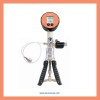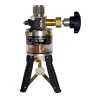A Dead Weight Tester (DWT) is a pressure calibration instrument which uses metal weights and a piston/cylinder assembly to generate pressure setpoints to a high accuracy over a wide range of pneumatic or hydraulic pressures.
Measurement Principle
Since pressure is derived from force divided by area (F/A), the pressure generated by a dead weight tester is calculated by multiplying the mass by the acceleration due to gravity to determine the applied force, and then dividing this by the surface area of the piston cylinder.
The pressure is applied by using a screwpress for hydraulic ranges and a gas regulator for pneumatic ranges. The desired pressure is reached when enough pressure has been applied via the screwpress or regulator to lift the weights so that they are floating.
Featured pressure calibration products
 PGS700 High Pressure Calibration Hand Pump - Hydraulic hand pump for applying test and calibration pressures with precision from 0 to 700 bar gauge (10,000 psi)
PGS700 High Pressure Calibration Hand Pump - Hydraulic hand pump for applying test and calibration pressures with precision from 0 to 700 bar gauge (10,000 psi) 100 bar / 1,500 psi Hand Operated Pressure Calibration Pump – ADT918 - The 918 Pneumatic Pressure Test Pump is a hand operated pressure pump designed to generate pressure from 95% vacuum to 1,500psi (100bar).
100 bar / 1,500 psi Hand Operated Pressure Calibration Pump – ADT918 - The 918 Pneumatic Pressure Test Pump is a hand operated pressure pump designed to generate pressure from 95% vacuum to 1,500psi (100bar).
Main Components
Typically a dead weight tester consists of a base, screwpress/regulator, piston/cylinder assembly and a mass set of weights.
The base has a built-in spirit level and adjustable feet to allow the user to ensure the instrument is perfectly level before use.
In the case of a hydraulic dead weight tester there will be a screwpress with turn-handles, and for pneumatic deadweight testers there will be a gas regulator built into the base.
A piston cylinder assembly is mounted vertically to the top of the base and connected via manifolds and pipework to the the screwpress or regulator. There are two markings on the piston cylinder which indicate the region in which the weights must be floating and spinning before checking the reading of the device being calibrated. Some deadweight testers come with piston cylinders of different sizes which extend the range of the instrument to higher or lower set of pressures.
The mass set is stored in a separate box and includes a series of different sized weights, each of which has a hole in the middle, so that the weight can be slid onto the mass holder which sits over the top of the piston cylinder assembly.
Featured pressure calibration products
 Suction Pressure Calibration Equipment - Select a calibration equipment for calibrating suction pressure measuring devices, and generating suction pressure for setting calibration points.
Suction Pressure Calibration Equipment - Select a calibration equipment for calibrating suction pressure measuring devices, and generating suction pressure for setting calibration points. Low Pressure Calibrators - Explore low pressure calibrators featuring fine volume adjustment pumps and high-accuracy indicators for precise calibration in Pa, mbar, or "WC ranges. Ideal for sensitive instruments.
Low Pressure Calibrators - Explore low pressure calibrators featuring fine volume adjustment pumps and high-accuracy indicators for precise calibration in Pa, mbar, or "WC ranges. Ideal for sensitive instruments.
Applications
A dead weight tester is often called a primary reference standard because it is considered to produce the most accurate results because the mass of the weights and the area of the piston cylinder are known to a very high accuracy. However there are many factors that can have a significant effect on the measurement uncertainty of a dead weight tester if not used correctly, such as incorrect local gravity correction, mass loss due to scratches on the weights, friction losses due to poor maintenance of the piston cylinder assembly and measurements taken without spinning the weights or ensuring the base is horizontal.
Today, dead weight testers are mainly used by standards laboratories to provide a reference standard for pressure calibration purposes. The introduction of more accurate and more efficient electronic based calibration equipment in recent years has caused a significant reduction in the number of dead weight testers used throughout industry.
Although the dead weight tester is now considered by many to be old fashioned and slow to operate, it will never be replaced entirely, because it remains the most precise instrument for ensuring pressure standards are maintained throughout industry with minimum impact on uncertainty.
Featured pressure calibration products
 High Pressure Range Calibrators - High range pressure calibrators for checking and testing the accuracy performance of high pressure measurement instrumentation.
High Pressure Range Calibrators - High range pressure calibrators for checking and testing the accuracy performance of high pressure measurement instrumentation. Low Pressure Calibrators - Explore low pressure calibrators featuring fine volume adjustment pumps and high-accuracy indicators for precise calibration in Pa, mbar, or "WC ranges. Ideal for sensitive instruments.
Low Pressure Calibrators - Explore low pressure calibrators featuring fine volume adjustment pumps and high-accuracy indicators for precise calibration in Pa, mbar, or "WC ranges. Ideal for sensitive instruments.
Accuracy Factors
To achieve the best accuracy from a dead weight tester the following factors should be considered when calculating the pressure reading:
Local Gravity
If the gravity at the location where the dead weight tester is being used is different to where it was calibrated then the readings will need to be corrected since the force generated by the weights will change.
Pressure Coefficient
The effective area of the dead weight tester will change with pressure due to the expansion and contraction of the piston and cylinder at different pressures.
Tare Force
This represents a force error in the determination of the mass of the weights, the calculation of the piston/cylinder and carrier weight or a known characteristic of the dead weight tester.
Horizontal Levelling
If the dead weight tester is not level with the horizontal plane and therefore the piston cylinder assembly is not perfectly upright there will be a friction force due to a leaning towards one side.
Air Buoyancy
The air pressure and humidity will affect the density of air which contributes a relatively small lifting force to the weights.
Thermal Expansion
As the temperature changes the cross sectional area of the piston and cylinder will change affecting the effective area of the dead weight tester.
Surface Tension
For fluid filled dead weight testers a surface tension force is exerted on the piston. This surface tension force depends on the type of fluid used and the circumference of the piston.
Height Difference
If the dead weight tester is used at a different height to the unit being tested, a force will be generated due to the head of air or fluid in the connecting test hose .
Featured pressure calibration products
 70bar/1000psi Benchtop Pneumatic Calibration Pump – ADT917 - Manual benchtop pneumatic pressure calibration pump for -1 bar to 70 bar with pressure and vacuum operation and fine adjustment.
70bar/1000psi Benchtop Pneumatic Calibration Pump – ADT917 - Manual benchtop pneumatic pressure calibration pump for -1 bar to 70 bar with pressure and vacuum operation and fine adjustment. Suction Pressure Calibration Equipment - Select a calibration equipment for calibrating suction pressure measuring devices, and generating suction pressure for setting calibration points.
Suction Pressure Calibration Equipment - Select a calibration equipment for calibrating suction pressure measuring devices, and generating suction pressure for setting calibration points.
Dead Weight Tester Help
LP & HP Operating Mode
In using our dead weight tester, we use a term called HP factor which is 10 or 20. The same weight is used for two different values in LP and HP operations. How will you explain this in technical terms?
The LP and HP operations are switching between to two piston cylinders with different cross-sectional areas. Since Pressure = Force / Area, a doubling of effective area would halve the pressure generated by the same weight. So it is a way stepping up/down the pressure range of a dead weight tester without the need for an extra set of weights.
Calculating pressure (basic method)
How do you tell how much pressure has been generated by a dead weight tester?
The calculation of pressure generated by a dead weight tester can be quite complicated if you are looking for high accuracy, but if we just consider the main parameters, all you need to know is the mass of the weights placed on top of the piston/cylinder and the cross sectional area of the piston.
To calculate the pressure you divide the weight of the mass applied by the cross sectional area of the piston.
In order to calculate the weight you will also need to multiple the applied mass by the local gravity, although if this is not known then standard gravity of 9.80665 m/s2 can be used instead as an approximation.
The calculation is as follows:
Pressure = Mass x Gravity / Cross Sectional Area
If you are using metric units you could calculate in kilogram force per square centimetre (kgf/cm2) or for imperial/american you could use pounds force per square inch (lbsf/sq in). These units can then be converted into any engineering unit using a pressure converter.
e.g. If mass = 2 kg, gravity = 9.80665 m/s^2, area = 3 sq cm, the resulting pressure will be 6.538 kgf/sq cm.
Please note this is a very basic calculation to demonstrate how a dead weight tester measures pressure, and in a calibration laboratory environment there a number of other factors that affect the measurement accuracy which need to be considered.
Alternatively you can use our online dead weight tester calculators to determine the pressure generated and the required mass.
Cross Float Method for DWT Calibration
What is the significance of the Cross Float Method in the calibration of dead weight pressure tester?
It is the method used to determine the cross sectional area of the piston cylinder which is one of the main factors in determining the accuracy of a dead weight tester. Known weights are added to the DWT under test until the pressure is balanced with a known comparison standard. The difference in weight applied to each standard is used to determine the difference in X-sectional area of the piston cylinder.
There are many factors that affect the performance of a dead weight tester, but the calibration of the piston / cylinder along with the mass sets in a separate procedure are the most important ones to ensure an accurate pressure reading.
Featured pressure calibration products
 DM01-500-HD High Range Digital Pressure Gauge - The DM01-500 HD high range pressure gauge is available in pressure ranges from 0 to 600, 1000, 1600, 2000 & 2200 bar.
DM01-500-HD High Range Digital Pressure Gauge - The DM01-500 HD high range pressure gauge is available in pressure ranges from 0 to 600, 1000, 1600, 2000 & 2200 bar. 200bar/3000psi Hand Operated High Air Pressure Test Pump – ADT920 - Manually generate air pressures up to 200 bar / 3000 psi for pressure testing and calibrating pressure measurement equipment.
200bar/3000psi Hand Operated High Air Pressure Test Pump – ADT920 - Manually generate air pressures up to 200 bar / 3000 psi for pressure testing and calibrating pressure measurement equipment.
Glossary of Calibration technical terms
- BSL – Best Straight Line
- Compensated Temperature Range
- NPL – National Physical Laboratory
- PPM – Parts Per Million
- Primary Pressure Reference Standard
- Secondary Pressure Standard
- Span Offset
- Traceable Calibration
- TSL – Terminal Straight Line
- UKAS – The United Kingdom Accreditation Service
- UKAS Calibration Certificate
- Zero Offset
- Zero Tare
Help from Calibration resources
- Determining calibration error of Bourdon tube pressure gauge
- What is the difference between zero offset and zero drift?

